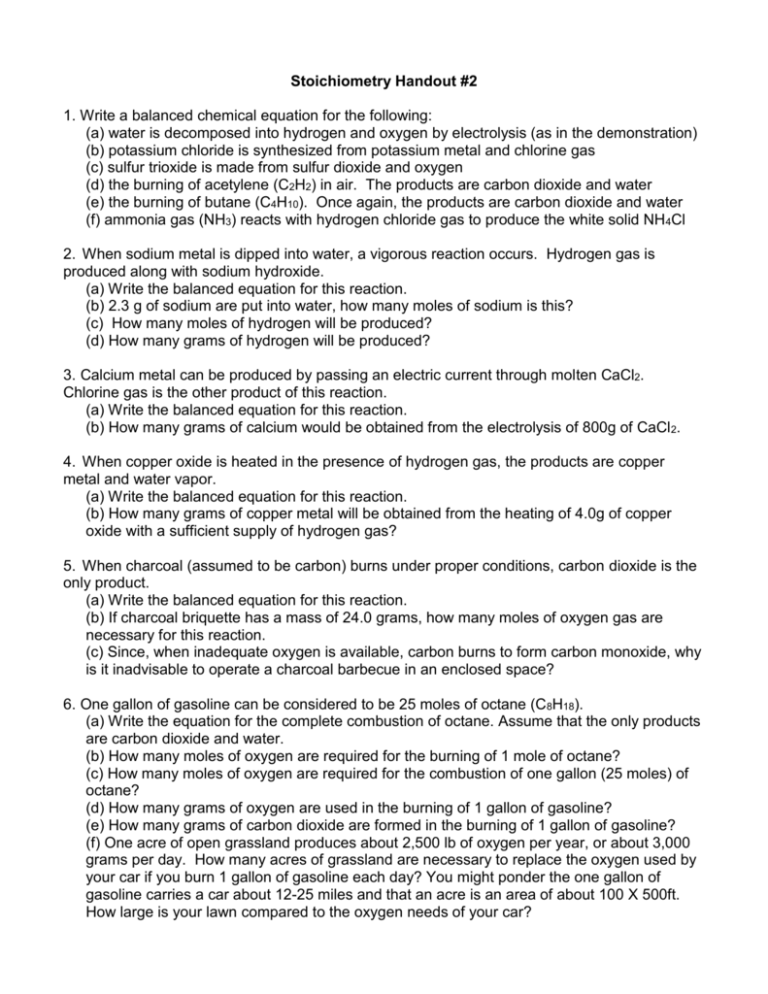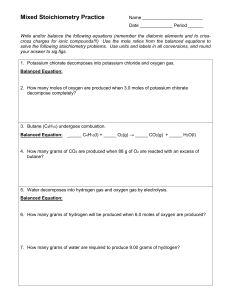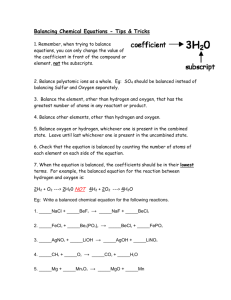Stoichiometry Handout #2
advertisement

Stoichiometry Handout #2 1. Write a balanced chemical equation for the following: (a) water is decomposed into hydrogen and oxygen by electrolysis (as in the demonstration) (b) potassium chloride is synthesized from potassium metal and chlorine gas (c) sulfur trioxide is made from sulfur dioxide and oxygen (d) the burning of acetylene (C2H2) in air. The products are carbon dioxide and water (e) the burning of butane (C4H10). Once again, the products are carbon dioxide and water (f) ammonia gas (NH3) reacts with hydrogen chloride gas to produce the white solid NH4Cl 2. When sodium metal is dipped into water, a vigorous reaction occurs. Hydrogen gas is produced along with sodium hydroxide. (a) Write the balanced equation for this reaction. (b) 2.3 g of sodium are put into water, how many moles of sodium is this? (c) How many moles of hydrogen will be produced? (d) How many grams of hydrogen will be produced? 3. Calcium metal can be produced by passing an electric current through molten CaCl2. Chlorine gas is the other product of this reaction. (a) Write the balanced equation for this reaction. (b) How many grams of calcium would be obtained from the electrolysis of 800g of CaCl2. 4. When copper oxide is heated in the presence of hydrogen gas, the products are copper metal and water vapor. (a) Write the balanced equation for this reaction. (b) How many grams of copper metal will be obtained from the heating of 4.0g of copper oxide with a sufficient supply of hydrogen gas? 5. When charcoal (assumed to be carbon) burns under proper conditions, carbon dioxide is the only product. (a) Write the balanced equation for this reaction. (b) If charcoal briquette has a mass of 24.0 grams, how many moles of oxygen gas are necessary for this reaction. (c) Since, when inadequate oxygen is available, carbon burns to form carbon monoxide, why is it inadvisable to operate a charcoal barbecue in an enclosed space? 6. One gallon of gasoline can be considered to be 25 moles of octane (C8H18). (a) Write the equation for the complete combustion of octane. Assume that the only products are carbon dioxide and water. (b) How many moles of oxygen are required for the burning of 1 mole of octane? (c) How many moles of oxygen are required for the combustion of one gallon (25 moles) of octane? (d) How many grams of oxygen are used in the burning of 1 gallon of gasoline? (e) How many grams of carbon dioxide are formed in the burning of 1 gallon of gasoline? (f) One acre of open grassland produces about 2,500 lb of oxygen per year, or about 3,000 grams per day. How many acres of grassland are necessary to replace the oxygen used by your car if you burn 1 gallon of gasoline each day? You might ponder the one gallon of gasoline carries a car about 12-25 miles and that an acre is an area of about 100 X 500ft. How large is your lawn compared to the oxygen needs of your car? 7. An average human being used about 500 kg of oxygen per year in an extremely complex series of reaction, one of which is C6H12O6 + O2 CO2 + H2O. (a) Balance the above equation. (b) How many moles of oxygen are contained in 500 kg of oxygen? (c) If an acre of grassland produces 1,000 kg of oxygen per year, how many people (considering oxygen requirements alone) can one acre of grassland support? 8. When a mole of aluminum metal is burned to Al2O3, 200 kcal of heat are given off. (a) Write the balanced equation for this reaction, including the energy term as part of the equation. (b) Is this reaction exothermic or endothermic? (c) If 100 grams of aluminum are completely burned, how much energy will be produced? 9. Metallic sodium is obtained chiefly by the electrolysis of molten sodium chloride (NaCl). For each mole of sodium produced, 98 kilocalories of electrical energy are needed. a) Write the balanced equation for this reaction, including the energy term as part of the equation. (b) Is this reaction endothermic or exothermic? (c) Write the balanced equation for the reaction of sodium with chloride gas. Include the energy term as part of the equation and indicate whether the reaction is exothermic or endothermic. (d) How much energy would be produced by the reaction of 11.5 grams of sodium with an excess of chlorine gas? 10. Methane, the main constituent of natural gas, has the formula CH4 and a molar heat of combustion of 18,000 calories. (a) Write the balanced equation for the burning of 1 mole of methane, including the energy term as part of the equation. 11. Liquid hydrogen was used as a fuel in the Saturn rockets which carried our astronauts to the moon. Hydrogen has a molar heat of combustion of 68.3 kcal. (a) Write the balanced equation for the combustion of 1 mole of hydrogen, including the energy term as part of the equation. (b) How many kilocalories of heat will be given off y the burning of 1.00 kg of hydrogen.




